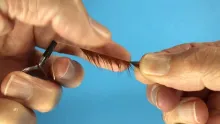Learn to tie a really classical wet fly hackle.




The classic soft hackle is not hard to do. By using this technique you can get a hackle that falls nicely towards the rear of the fly and will add very little bulk under a head.
The best feathers for this type of hackle are full, fairly dense and soft in the barbs - but not webby and marabou like. The classic hen hackle like Hoffmann softhackle, hen sets or Chickabou are excellent, but the partridge feather and the red or yellow golden pheasant body feathers are well suited too. Certain flies will do fine with low quality rooster hackles like those found on many Chinese or Indian necks and saddles. These are more spiky and less full, but can be sufficient.
- You might want to remove the webby part of the barbs before using the feather.
- Grab a few of the barbs in the tip of the feather and stroke back the rest towards the base of the stem with moist fingers so that the barbs become perpendicular to the hackle stem.
- The hackle is tied in with this small tip first and the 'good' side towards yourself and the hackle stem pointing upwards.
- Two to three tight turns will hold the hackle, but you might want to advance the thread a few more turns to form a smooth base for the hackle.
- Now grab the stem with the right hand and pull up.
- Moist the thumb and index finger of the left hand and grab the barbs and push/pull them away from yourself.
- While holding the feather tightly upwards you now pull the barbs towards the rear of the hook thus folding the barbs on the right side of the stem behind the stem and to the rear, parallel with the left side barbs.
- While still holding the barbs, start winding the feather away from yourself over the hook shank. Follow the motion of the feather with the left hand holding the barbs.
- Keep the barbs tight and pull lightly downwards while letting shortly go of the stem. Turn your right hand with the little finger up and grab the stem with thumb and index finger again
- Wind on downwards and up on your side of the shank.
- In doing this you have to let go of the barbs shortly and move your left hand back under the hook shank and grab them again from the front, but still pulling towards the rear of the hook.
- Keep on turning the feather up and over the hook shank in front of the first turn of the hackle.
- Now you are back at the starting position and can continue the winding in front of the first turn.
- It is very important to keep the stem untwisted and to constantly pull/stroke back the barbs in order not to catch any under the next turn of the hackle. The stem is square in cross section and will not twist if this is done correctly.
- When you are satisfied you can either turn the hook upside-down and take a couple of turns of thread over the stem (if you use a rotary vice) or you can pull the stem towards yourself and catch it with the thread under the hook shank.
- Be careful not to tie down any barbs under the thread. These will press down the nicely turned hackle.
- One solution to the above problem is to unwind the last turn of the hackle and strip off excess barbs, wind the last turn on again and tie down the bare piece of stem.
- Another solution is to catch the stem with one turn of thread and wiggle the hackle horizontally back and forth until all barbs are free of the thread.
A piece of general advice is to tie the hackle fairly sparse. For a full feather 2-4 turns will normally do and for a very lightly dressed fly like a spider, you can strip one half of the barbs before turning the hackle. Using the above method you will want to remove all the barbs on the right side - over the hook eye. For spiders one or two turns of hackle will often do.
I only use hackle pliers for the smallest and shortest feathers like partridge or golden pheasant body feathers.
- Log in to post comments








